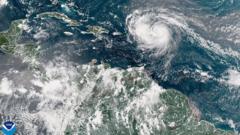Hurricane Erin has rapidly intensified, now classified as a category five hurricane, showcasing maximum sustained winds of 160 mph (260 km/h). According to Mike Brennan, Director of the National Hurricane Center, the storm exhibited "explosive deepening" overnight and is the first hurricane of the 2025 Atlantic hurricane season, having progressed from tropical storm status within a single day.
Forecasts indicate that Erin will pass to the north of both the Leeward Islands and Puerto Rico during the forthcoming weekend, likely bringing significant rainfall totaling up to 6 inches (15 cm). This poses a risk of flash flooding and landslides in affected areas.
"Ninety percent of Hurricane Erin’s wind speeds accelerated remarkably from 100 mph to 160 mph within just that rapid intensification period,” stated Brennan. The storm is predicted to traverse gradually northward next week, skirting the east of the Bahamas and heading toward the Outer Banks in North Carolina.
Dangerous surf and rip currents are anticipated along nearly the entire Eastern Seaboard of the United States in the upcoming week, with states in Florida and the mid-Atlantic region expected to endure the worst of the conditions. Bermuda is also bracing for severe surf and heavy rainfall, creating hazardous circumstances.
In response to the gale-force winds associated with Hurricane Erin, the US Coast Guard has enacted port restrictions for vessels in St Thomas and St John in the US Virgin Islands, as well as in six municipalities in Puerto Rico, including the capital city, San Juan.
Notably, the National Oceanic and Atmospheric Administration (NOAA) has issued warnings indicating an "above normal" hurricane season this year, with a concerning projection for an increase in category four and five storms, influenced by rising global temperatures.




















